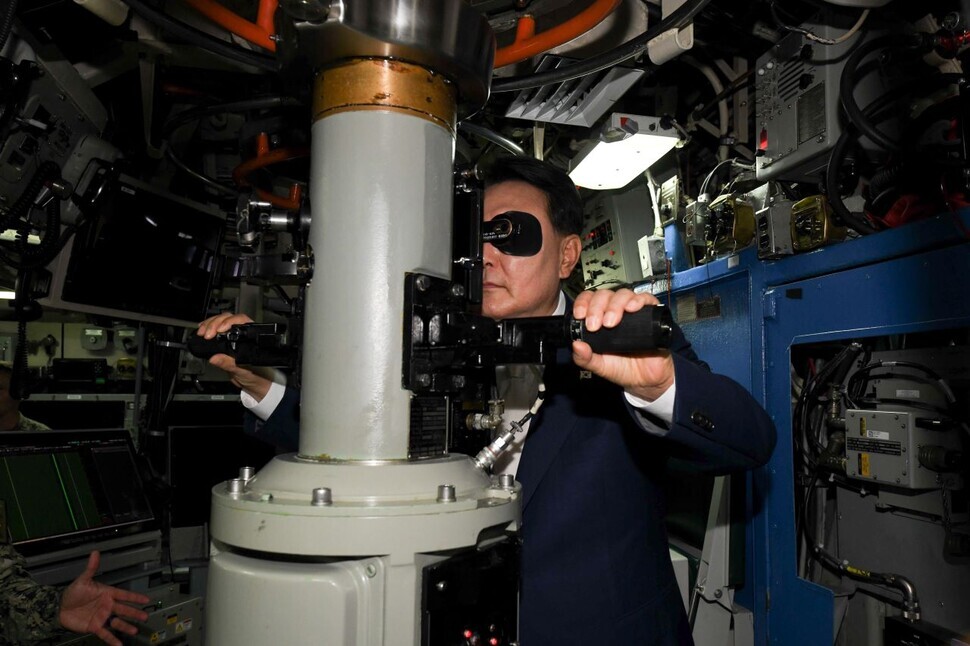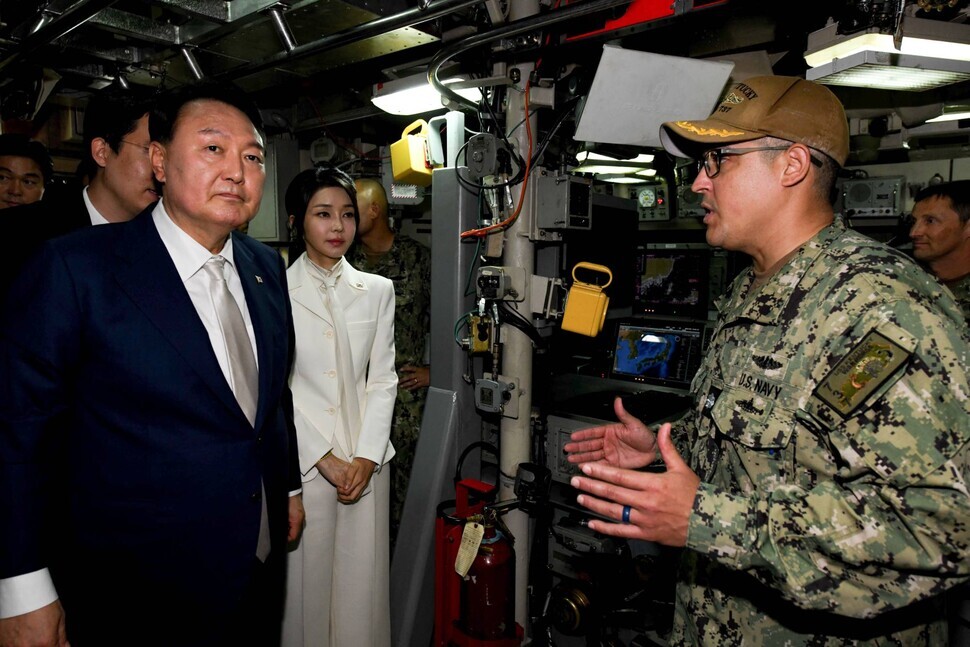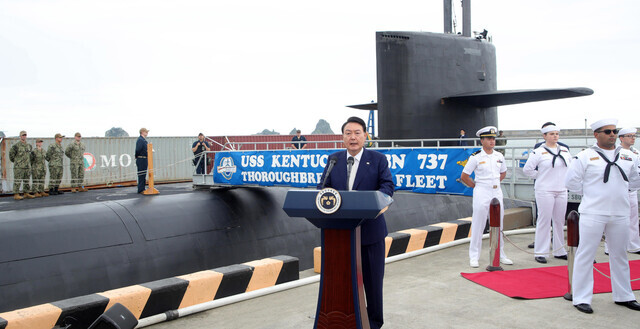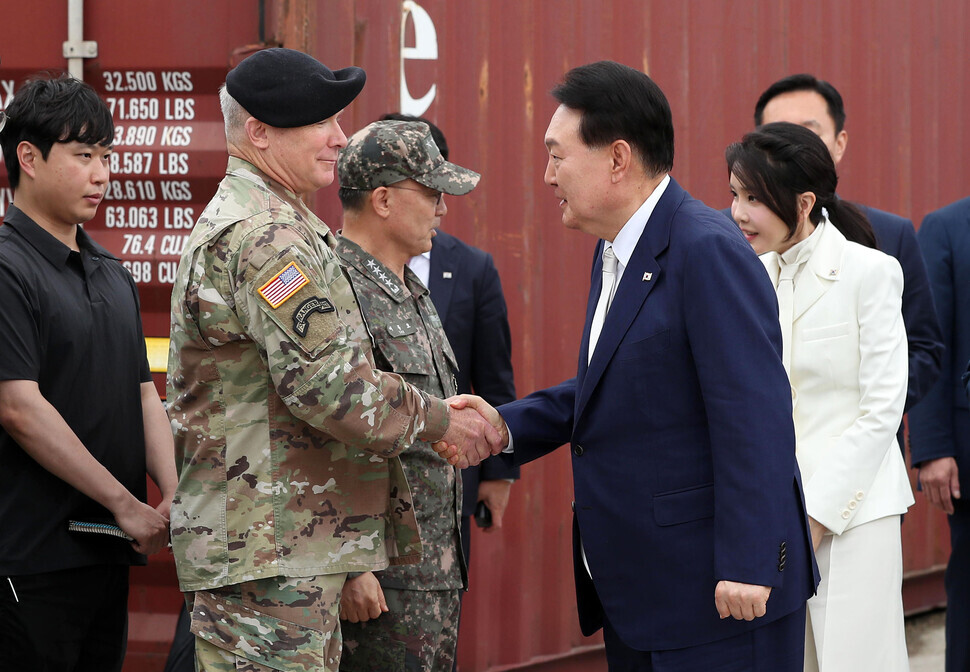hankyoreh
Links to other country sites 다른 나라 사이트 링크
Aboard American sub capable of razing N. Korea, Yoon boasts of US extended deterrence

For the first time in 42 years, a US Ohio-class nuclear-powered ballistic missile submarine (SSBN), capable of carrying nuclear weapons, has made a port call in Busan. This prompted North Korea to launch two short-range ballistic missiles into the East Sea early on Wednesday. Later in the day, South Korean President Yoon Suk-yeol inspected the USS Kentucky (SSBN-737), alongside South Korean and US naval commanders. This marked the first time a South Korean president has visited a US strategic asset deployed within the country.
North Korea appears set to continue its shows of force ahead of the 70th anniversary of the signing of the armistice agreement that paused the hostilities of the Korean War on July 27, a holiday known as “Victory Day” in the North. South Korea and the US, on the other hand, are responding to North Korea’s moves by deploying American strategic assets to the peninsula, leading to escalating tensions all around.

On Wednesday afternoon, Yoon toured the USS Kentucky at the Busan Naval Base. His presence aboard the strategic nuclear submarine, armed with nuclear missiles that could decimate North Korea, can be seen as a stern warning that nuclear provocations could result in the end of the regime.
“It is meaningful and truly reassuring to visit the USS Kentucky, one of the most powerful strategic assets in existence,” Yoon said in remarks at the naval base that day. “The deployment of the USS Kentucky clearly demonstrates the will of South Korea and the US to regularly deploy American strategic assets and strengthen the ability to execute extended deterrence.”
US strategic nuclear submarines seldom make public appearances in foreign countries due to their involvement in strategic missions directed by the US president and the US Strategic Command. Yoon himself stated, “I believe I am the first president of a US-allied country to visit an SSBN.”

In welcoming remarks, Gen. Paul LaCamera, commander of the US Forces Korea (USFK), described the USS Kentucky as a vital part of the US nuclear triad, alongside strategic bombers and intercontinental ballistic missiles (ICBMs). He also emphasized that strategic nuclear submarines, being the most survivable leg of the US nuclear triad, are a crucial element of the extended deterrence the US provides to South Korea.
Before stepping aboard the submarine, Yoon referenced the inaugural meeting of the Nuclear Consultative Group, which took place the previous day, in a speech to South Korean and US military officials, saying, “South Korea and the United States will continue to decisively respond to the escalating nuclear and missile threat from North Korea through the Nuclear Consultative Group and the regular deployment of strategic assets like SSBNs.”
He also warned, “[We] have clearly stated that if North Korea initiates a [nuclear] provocation, it could lead to the end of its regime.”

Earlier the same day, South Korea’s Joint Chiefs of Staff reported that North Korea had launched two SRBMs from the Sunan area in Pyongyang, which both flew for 550 kilometers before splashing down in the East Sea. These launches are believed to have been in response to the USS Kentucky’s port call in Busan, as the submarine’s nuclear missiles can strike anywhere in North Korea.
Appearing on a radio broadcast, South Korea’s vice defense minister, Shin Beom-chul, drew attention to the fact that the distance covered by the missiles is approximately the same as the distance from Pyongyang to Busan, suggesting that North Korea is very much aware of the US strategic nuclear submarine.

The unyielding attitudes of North Korea, South Korea, and the United States are only adding to the increasing instability of the situation on the Korean Peninsula.
North Korea has been escalating its hard-line posture, with Kim Yo-jong, the politically influential sister of North Korean leader Kim Jong-un, issuing aggressive statements to the US and the North Korean military launching two SRBMs following its test of the Hwasong-18, a solid-fuel ICBM, on July 12.

Kim Dong-yup, a professor at the University of North Korean Studies in Seoul, anticipates that “these provocations will escalate due to the North Korean military’s ongoing summer training period and the upcoming Victory Day holiday.”
A former South Korean diplomatic and security official emphasized, “[We] must prevent any accidental clashes from escalating into conflicts by easing unnecessary tensions.”
By Kwon Hyuk-chul, staff reporter; Shin Hyeong-cheol, staff reporter; Kim Mi-na, staff reporter
Please direct questions or comments to [english@hani.co.kr]

Editorial・opinion
![[Editorial] Perilous stakes of Trump’s rhetoric around US troop pullout from Korea [Editorial] Perilous stakes of Trump’s rhetoric around US troop pullout from Korea](https://flexible.img.hani.co.kr/flexible/normal/500/300/imgdb/original/2024/0509/221715238827911.jpg) [Editorial] Perilous stakes of Trump’s rhetoric around US troop pullout from Korea
[Editorial] Perilous stakes of Trump’s rhetoric around US troop pullout from Korea![[Guest essay] Preventing Korean Peninsula from becoming front line of new cold war [Guest essay] Preventing Korean Peninsula from becoming front line of new cold war](https://flexible.img.hani.co.kr/flexible/normal/500/300/imgdb/original/2024/0507/7217150679227807.jpg) [Guest essay] Preventing Korean Peninsula from becoming front line of new cold war
[Guest essay] Preventing Korean Peninsula from becoming front line of new cold war- [Column] The state is back — but is it in business?
- [Column] Life on our Trisolaris
- [Editorial] Penalties for airing allegations against Korea’s first lady endanger free press
- [Editorial] Yoon must halt procurement of SM-3 interceptor missiles
- [Guest essay] Maybe Korea’s rapid population decline is an opportunity, not a crisis
- [Column] Can Yoon steer diplomacy with Russia, China back on track?
- [Column] Season 2 of special prosecutor probe may be coming to Korea soon
- [Column] Park Geun-hye déjà vu in Yoon Suk-yeol
Most viewed articles
- 1‘Free Palestine!’: Anti-war protest wave comes to Korean campuses
- 2[Editorial] Perilous stakes of Trump’s rhetoric around US troop pullout from Korea
- 3Behind-the-times gender change regulations leave trans Koreans in the lurch
- 4Nuclear South Korea? The hidden implication of hints at US troop withdrawal
- 5[Photo] ‘End the genocide in Gaza’: Students in Korea join global anti-war protest wave
- 6Korean president’s jailed mother-in-law approved for parole
- 760% of young Koreans see no need to have kids after marriage
- 8In Yoon’s Korea, a government ‘of, by and for prosecutors,’ says civic group
- 9[Guest essay] Preventing Korean Peninsula from becoming front line of new cold war
- 10Yoon’s revival of civil affairs senior secretary criticized as shield against judicial scrutiny